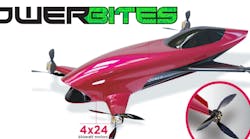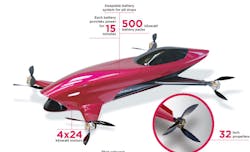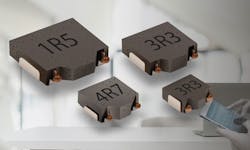Shades of Skywalker! Will electric air racing eclipse NASCAR? Is power management for complex SoCs really possible? Can artificial intelligence provide real benefits for EV power trains and wind turbines? The answers to these urgent questions and more await you in this next installment of PowerBites.
Forget Formula E: Electric Racing Goes Airborne
At first glance, it looks like one of many remotely piloted racing drones made to zoom through impossible-seeming mazes of obstacles at dizzying speeds—until you realize it's well over 10 feet in length and notice the cockpit where a live human being will pilot it from. The prototype racer, built by Airspeeder, is a proof-of-concept for the type of vehicle that competes in a unique form of low-level air racing, skimming along a closed course between 15 and 150 feet above the ground at speeds of up to 125 miles per hour.
You can watch the racer in action in the video below, or get more details at Airspeeder's website, or a recent profile about them in Electrek.
Smart Controller Simplifies Power Conversion for Smart Devices
STMicroelectronics’ VIPer222 controller is a highly integrated solution for high-voltage converters up to 8 W. It brings a compact footprint, reduced BOM costs, and versatility to applications such as home appliances, building-automation devices, smart lighting, and smart meters. Its integrated features, which include an error amplifier, current-sensing MOSFET, and high-voltage startup circuitry, allow the VIPer222 to be used in a wide variety of popular converter topologies, such as non-isolated flyback converters, isolated flyback converters with primary- or secondary-side regulation using a photocoupler, buck converters, and buck-boost converters.
The VIPer222 has been designed for high reliability and includes a 730-V avalanche-rugged power stage, short-circuit protection, and thermal protection. It also offers pulse-skipping protection, soft start, and circuitry to manage burst-mode operation for enhanced efficiency at light load. The controller IC supports a wide operating voltage range (4.5 to 30 V) and a low startup voltage (30 V) for greater versatility, and has the ability to start at very low supply voltages. Its light-load power consumption of less than 40 mW simplifies compliance with eco-design guidelines, and the jittered PWM controller enables the use of small filter components.
The VIPer222 is in production now and available in a 5- x 4-mm SSOP10 from $0.33 for orders of 1,000 pieces. Please visit www.st.com/viper222-pr for further information.
Rugged Low-Profile Shielded Power Inductors Feature Very Low Copper Losses
Bourns Inc. introduced 11 new low-resistance, high-saturation-current models to its shielded power inductor line. The Model SRP0xxx series consists of very low profile (less than 2 mm) devices that feature a metal-alloy powder core and flat wire construction, which offers low copper loss and dc resistance, low audible core noise, and high current saturation. Their shielded construction also leads to excellent temperature stability, and delivers good EMI performance.
The assembly process includes external laser welding between wire and terminal, which eliminates potential mechanical stress on the solder joint from the high pressure-molding process. In addition, the inductor's alpha-winding construction enables a wider inductance range at a given form factor while maintaining a very low-height profile across all of the new series' inductance values. Available now, all 11 new Bourns Model SRP0xxx inductors are RoHS-compliant and halogen-free. For additional product information, visit the product series' home page.
Partnership Aims to Bring Real Benefits of AI to Power Systems in EVs, Renewables
Pre-Switch Inc. appointed Foxy Power GmbH, located in Berlin, Germany as its strategic partner for business development and sales of its artificial-intelligence-based dc-ac, ac-dc soft-switching controller technology. Bruce Renouard, CEO of Pre-Switch, says that Foxy Power's solid relationships with many top global automotive OEMs and automotive suppliers will help accelerate acceptance of Pre-Switch's technology, bringing its efficiency and performance benefits to a wide range of applications including electric vehicles (EVs) and renewables.
Founded in 2016, Pre-Switch uses AI to constantly adjust the relative timing of elements within a power switching system required to force a resonance to offset the current and voltage waveforms, thereby minimizing switching losses. Beyond EVs and renewables, other key applications include solar inverters, wind turbines, UPS, storage, and motor drives.
Ultra-Compact Gate-Driver IC Brings Error-Free Triggering to Low-Voltage Apps
Infineon's EiceDRIVER 1EDN TDI family of 1-channel gate drivers for power MOSFETs makes it possible to design low-voltage power-conversion applications that are dramatically more compact and less susceptible to false triggering than previous solutions. The driver features a new package design with a footprint that’s 1/5th the size of conventional designs. It also has truly differential inputs (TDIs) that practically eliminate false triggering of the driver. They counter the effects of the parasitic inductances that produce ground-shifts each time a power MOSFET is being turned on or off.
The new device (1EDN7550U) is housed in either a standard SOT-23 6-pin package, or an ultra-compact (1.5 × 1.1 × 0.39 mm) 6-pin leadless TSNP package that occupies five times less PCB area than its SOT-23 family members. With a 3.3-V PWM input signal at application level, the EiceDRIVER 1EDN TDI can withstand static ground-shifts of up to ±70 V and transient ground-shifts of as much as ± 150 Vpeak. These gate-driver ICs can also be paired to operate in a 48-V half-bridge configuration.
The driver housed in the TSNP package is a 4-V UVLO device; other versions packaged in the SOT-23 are rated at 4 V and 8 V. Sample pricing is approximately $1.50 and volume cost is just over 50 cents. Additional information, including product brief and application note, can be accessed by clicking here.
Power Management Without Tears: New PMIC Reference Designs for Popular FPGAs, SoCs
Renesas released three easy-to-use power-management IC (PMIC) reference designs for powering the multiple supply rails of Xilinx Artix-7 FPGAs, Spartan-7 FPGAs, and Zynq-7000 SoCs (with or without DDR memory). The reference designs speed the development of power supplies for a variety of industrial and computing applications, including motor control, machine-vision cameras, programmable logic controllers (PLCs), home gateways and appliances, and portable medical and wireless equipment.
The high-efficiency PMIC reference designs provide user-friendly turnkey solutions that enable a single design to support different Xilinx speed grades and DDR memory types: DDR3, DDR3L, DDR4, LPDDR2, and LPDDR3. They’re based on the four-phase, three output ISL91211AIK PMIC, and the four-output ISL91211BIK PMIC.
Both PMICs can deliver up to 20 A total output current and feature independent dynamic voltage scaling. Their control loops are tuned to optimally support the load profiles of Xilinx FPGAs. They manage power-up and shutdown sequencing of their rails internally, without requiring external sequencing controllers. Applying 2-MHz switching frequency and fast load transient response enables each PMIC board to use 22-µF output capacitors and a small inductor to reduce solution size. The PMICs come in 4.7- × 6.3-mm, 35-ball BGA with 0.8-mm pitch packages.
PMIC reference design boards, which come with a user’s guide, complete schematic, bill of materials (BOM), and PCB layout files, include:
- The ISL91211A-BIK-REFZ reference board for Artix-7 FPGAs ($168.00 USD)
- The ISL91211BIK-REF2Z reference board for Spartan-7 FPGAs ($160.00 USD)
- The ISL91211AIK-REFZ reference board for Zynq-7000 SoCs ($160.00 USD)



